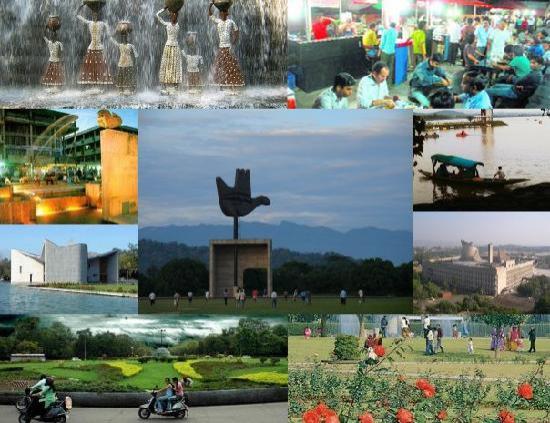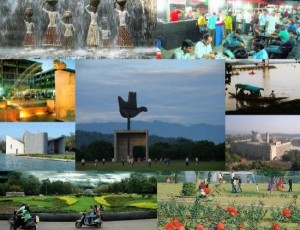 Chandigarh, the dream city of India’s first Prime Minister, Sh. Jawahar Lal Nehru, was planned by the famous French architect Le Corbusier. Picturesquely located at the foothills of Shivaliks, it is known as one of the best experiments in urban planning and modern architecture in the twentieth century in India.Chandigarh derives its name from the temple of “Chandi Mandir” located in the vicinity of the site selected for the city. The deity ‘Chandi’, the goddess of power and a fort of ‘garh’ laying beyond the temple gave the city its name “Chandigarh-The City Beautiful”.
Chandigarh, the dream city of India’s first Prime Minister, Sh. Jawahar Lal Nehru, was planned by the famous French architect Le Corbusier. Picturesquely located at the foothills of Shivaliks, it is known as one of the best experiments in urban planning and modern architecture in the twentieth century in India.Chandigarh derives its name from the temple of “Chandi Mandir” located in the vicinity of the site selected for the city. The deity ‘Chandi’, the goddess of power and a fort of ‘garh’ laying beyond the temple gave the city its name “Chandigarh-The City Beautiful”.
Chandigarh is the 1st planned modern city of India designed by the French architect Le Corbusier. Chandigarh and the area surrounding it were constituted as a union territory on 1st November, 1966. It serves as the joint capital of both, Punjab and Haryana states. It is bounded on the north and west by Punjab and east and south by Haryana. Total area of the union territory is 114Sq.Km.
The Chandigarh is located in north of India and surrounded by three states Punjab, Haryana, and Himachal Pradesh. The Chandigarh city is situated in a picturesque setting under the foot of Shivalik Hills at a height of 365 meters above the sea level. Geographically its boundaries are defined by two seasonal rivulets – the Patiali ki Rao and the Sukhna choe.
Chandigarh covers an area of approximately 114 km². and shares its borders with the states of Haryana in the south and Punjab in the north. It has an average elevation of 321 meters (1053 feet).The surrounding districts are of Mohali, Patiala and Ropar in Punjab and Panchkula and Ambala in Haryana. The boundary of the state of Himachal Pradesh are not too far from its north.The government is a major employer in Chandigarh with three governments having their base here. A significant percentage of Chandigarh’s population therefore consists of people who are either working for one of these governments or have retired from government service. For this reason, Chandigarh is often called a “Pensioner’s Paradise”.
History
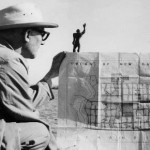 August 15, 1947, the day of independence of India was also the day of division of a nation into India and Pakistan, this was also the day of division of State of Punjab (Punj+Aab) named so for being the land of five rivers being divided into two states West Punjab gone in Pakistan with retaining Lahore as its capital and East Punjab in India became a state without a capital. Shimla which used to be the summer capital of India and had the infrastructure was selected as the temporary capital of Punjab.
August 15, 1947, the day of independence of India was also the day of division of a nation into India and Pakistan, this was also the day of division of State of Punjab (Punj+Aab) named so for being the land of five rivers being divided into two states West Punjab gone in Pakistan with retaining Lahore as its capital and East Punjab in India became a state without a capital. Shimla which used to be the summer capital of India and had the infrastructure was selected as the temporary capital of Punjab.
The Government of Punjab selected brilliant young engineer Mr. P.L. Verma to undertake the tasks of search for a permanent Capital City for the State of Punjab.At that time the Punjabis were very nostalgic about Lahore. Till the last moment they hoped that Lahore would remain with India. The loss was felt acutely and people were eager for a city similar to Lahore be built. So Verma and his team of engineers savoured the concept of a larger independent town, when most of the bureaucrats and politicians favoured the concept of a small settlement attached to one of the existing towns. Bureaucrats were conscious of the acute shortage of funds and the very small financial outlay for Punjab. Each politician was eager that this capital be built in the area from where he came. All politicians were trying to pull the capital towards their own constituency.
Under such circumstances Mr. Verma had to lobby intensively with the bureaucrats and the politicians. And it was essentially an account of his dedicated and relentless efforts and lobbying that this idea of a large independent town was finally accepted by Government of Punjab.
Places Of Interest
The Rock Garden of Chandigarh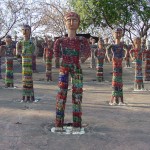
This sprawling amusement kingdom has been made completely from waste materials, industrial waste and thrown-away items, Created by celebrated artist Nek Chand, the garden highlights the value of materials many people consider trash.
Spread in an area of about 25 acres set in large mosaic courtyards linked by walled paths and deep gorges the garden is built by transforming into art, discarded tube lights, rusting oil drums, broken tiles, shattered china and sanitary ware, glass bangles, unused building material, discarded street lights, burnt bricks, electrical fittings and wires, caps from bottles, bicycle handle bars, and other scrap.The Rock Garden Chandigarh is designed to look like a lost kingdom. Doorways and archways constructed out of discarded bags of cement seem to characterize the theme, and the scale is larger than life. The rock garden is a complex labyrinth, with paths, gateways, steps, waterfalls, courtyards, porches and buildings. Much of the material that the Rock Garden is made out of is concrete and found objects.The rock garden proceeds in a chronological order of its creation, and in the unfolding shows the process of creation. Starting with a few natural forms and found objects like misshapen rocks, to minor landscape modification finally leading to a large scale architectural environment. In the second phase Nek Chand created open courtyards, pathways decorated with sculptures, complete with the king’s and queen’s chambers. A large waterfall, a canal, an open air theatre, a miniature village was also included. These architectural spaces have become an interactive space, where plays, dance and music performances are held.In the third and probably the final phase of development life sized horses and camels are being made again out of waste.At least 5,000 sculptures are viewed by the same number of visitors each day.The Chandigarh Rock Garden is now acknowledged as one of the modern wonders of the world.
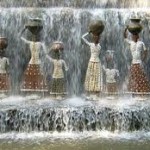 The place is magnificient and really worth spending at least 2 hours on any good day . It is a masterpiece in itself a brainchild of Mr Nek Chand and sponsored by Chandigarh administration . The unique creations made out of the city waste and the brain put in to produce magnificient artifacts is worth saluting. It is in north Chandigarh the most prime and beautiful spot in the City beautiful. Not only are the grounds a fun place to explore, they form a sort of oasis as well. Lots of shade and water features that cool you down. This is not high art but the exuberance of imagination is something that any age person can enjoy with a smile. A couple of spots along the way to buy drinks and snacks. The grounds are spotless and clean.
The place is magnificient and really worth spending at least 2 hours on any good day . It is a masterpiece in itself a brainchild of Mr Nek Chand and sponsored by Chandigarh administration . The unique creations made out of the city waste and the brain put in to produce magnificient artifacts is worth saluting. It is in north Chandigarh the most prime and beautiful spot in the City beautiful. Not only are the grounds a fun place to explore, they form a sort of oasis as well. Lots of shade and water features that cool you down. This is not high art but the exuberance of imagination is something that any age person can enjoy with a smile. A couple of spots along the way to buy drinks and snacks. The grounds are spotless and clean.
Pinjore Gardens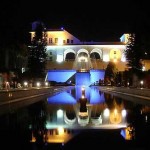
Chandigarh, is surrounded by numerous beautiful places that serve as ideal destinations for excursions. The Pinjore Garden is one of those places that has emerged as an important tourist attraction that one can visit when on a holiday to this city or is going towards from Chandigarh to Shimla.
Chandigarh Pinjore Gardens, also called Yadavindra Gardens are 20 km from Chandigarh, 15 km from Panchkula, on the Chandigarh Shimla national highway number 21. Taxis and buses ply regularly between Pinjore, Kalka, Panchkula and Chandigarh. The fascinating Mughal Garden (now popularly called Pinjore Garden) cover a total area of 100 acres. A mini zoo, plants nursery, a Japanese garden, historic palaces and picnic lawns await tourists. Especially at weekends, fountains are switched on and after dusk, lights pick up the beauty of the palaces by night.Nawab Fadai Khan, a great architect and foster brother of the Mughal emperor Aurangzeb is said to have designed the idyllic gardens. He planned the Gardens on the classical Charbagh pattern, giving the area a central water way. Both sides of this waterway were covered with patches of green bordered with flowers and shaded by trees. He supervised the construction of the stylistic Sheesh Mahal (palace of glass), the Rang Mahal (painted palace), and the cube-like Jal Mahal (palace of water).Like other Mughal gardens, this one also has a sloping ground and is decorated with fountains and grand and beautiful pavilions. There is a channel of water in the middle of the garden. The fountains are located inside this channel of water. There are walkways located on both sides of the channel.
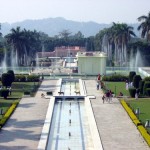 Lined with huge trees and a stretch of green grass, these walkways add to the beauty, charm and elegance of the Pinjore Garden. If you walk straight down, you will arrive at a huge pavilion, which offers marvelous view of the entire garden. The pavilion also has a terrace with a water body located in the center.
Lined with huge trees and a stretch of green grass, these walkways add to the beauty, charm and elegance of the Pinjore Garden. If you walk straight down, you will arrive at a huge pavilion, which offers marvelous view of the entire garden. The pavilion also has a terrace with a water body located in the center.
Special programs are arranged at the Yadavindra Gardens for the Baisakhi (spring) festival in April and for the Mango Festival in June and July. The gardens have cool, shady walks and flagged pathways which run to the outer reaches of the creeper-covered walls. The end structure of the doorway has recently been made into a disc-like open-air theatre.
Sukhna Lake
This is one of the most picturesque man made lakes in India. The Chandigarh lake Sukhna being an inseparable part of the city was created in 1958 by damming the Sukhna Choe. It had a depth of 18 feet originally and was spread across 3 sq km. True to its name Sukhna which implies a wish – fulfilled, the lake is an idyllic resort to enjoy nature at its best.At the entrance to the Sukhna Lake Chandigarh one reads Corbusier’s Edict of the Lake. “The founders of Chandigarh have offered this Chandigarh lake and dam to the citizens of the new city so that they may escape the humdrum of the city life and enjoy the beauty of nature in peace and silence.”The curvilinear 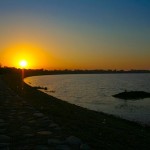 profile of the promenade along the banks of lake Sukhna hums with activity from dawn to dusk, reflecting changing moods of the day. The tree-shaded promenade is a favorite spot to stroll and enjoy the tranquil ambience.This is beautiful man made lake. The plus points are: very calm, soothing good trek for the people who love to walk. Although, the snack corners n the food quality could be improved. The entry is crowded on the weekend but as you walk approximately 500 meters ahead, the silent and calm area starts. A must do in the summer evenings if you are travelling to chandigarh . The lake has a great walking track. You can quickly leave the vendor area behind and enjoy the view and the greenery. Chandigarh has so many parks, but this one excels for really setting a pace and stretching your legs.
profile of the promenade along the banks of lake Sukhna hums with activity from dawn to dusk, reflecting changing moods of the day. The tree-shaded promenade is a favorite spot to stroll and enjoy the tranquil ambience.This is beautiful man made lake. The plus points are: very calm, soothing good trek for the people who love to walk. Although, the snack corners n the food quality could be improved. The entry is crowded on the weekend but as you walk approximately 500 meters ahead, the silent and calm area starts. A must do in the summer evenings if you are travelling to chandigarh . The lake has a great walking track. You can quickly leave the vendor area behind and enjoy the view and the greenery. Chandigarh has so many parks, but this one excels for really setting a pace and stretching your legs.
Rose Garden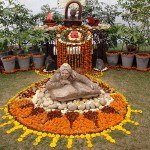
A 500 sq. meter park popular for its flowers and landscaping. A popular place to find various Types of Rose. A very peaceful ambience. Near to Shanti Kunj and Art Gallery. Nice place for evening walk with your loved ones. Once can find love birds holding each other hand and walking around, Well known with old school guys for their. The collection of roses is stupendous. Even without spectacular blooms the garden is enjoyable and very well designed for strolling for every age visitor.
Morni Hills
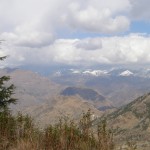 The only hill station of Haryana is an ideal place for picnic and short trips all the year around. Morni Hills are about and hours distance from Chandigarh (45 Kilometers) winding through hill tracks, forest cover and pine trees, Morni Hills delight with picturesque location. The place is still unexplored and very picturesque and green with a mixture of hill and plain vegetation in mountainous surroundings.The village of Morni lies on the mountainside, at 1220 meters or 3600 feet above sea level. Situated in the lower reaches of the Shivalik range, Morni is ideal for a holiday with its cool climate, beautiful natural vistas and myriad opportunities for bird watching, trekking, rock-climbing and other adventure sports.
The only hill station of Haryana is an ideal place for picnic and short trips all the year around. Morni Hills are about and hours distance from Chandigarh (45 Kilometers) winding through hill tracks, forest cover and pine trees, Morni Hills delight with picturesque location. The place is still unexplored and very picturesque and green with a mixture of hill and plain vegetation in mountainous surroundings.The village of Morni lies on the mountainside, at 1220 meters or 3600 feet above sea level. Situated in the lower reaches of the Shivalik range, Morni is ideal for a holiday with its cool climate, beautiful natural vistas and myriad opportunities for bird watching, trekking, rock-climbing and other adventure sports.
There are two lakes, which seem to be mysteriously interconnected, even though they are separated by a hillock.The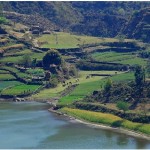 water level in both the lakes always remains the same, as there is a hidden channel under the hill connecting them. The larger is about 550 meters long and 460 meters broad and the other about 365 meters either way. Morni has a fascinating range of flora and fauna. Pines crown the hilltops and trees like neem, oak, pipal, jamun, amaltas and jacaranda cover the slopes.When the flowering trees blossom, the hillsides are awash with color, presenting a delightful sight. Morni is a paradise for wildlife enthusiasts and birdwatchers with its teeming population of birds like quails, sand grouse and common doves as well as animals like jackals, hyenas, sambhars and even a jungle cat or two.
water level in both the lakes always remains the same, as there is a hidden channel under the hill connecting them. The larger is about 550 meters long and 460 meters broad and the other about 365 meters either way. Morni has a fascinating range of flora and fauna. Pines crown the hilltops and trees like neem, oak, pipal, jamun, amaltas and jacaranda cover the slopes.When the flowering trees blossom, the hillsides are awash with color, presenting a delightful sight. Morni is a paradise for wildlife enthusiasts and birdwatchers with its teeming population of birds like quails, sand grouse and common doves as well as animals like jackals, hyenas, sambhars and even a jungle cat or two.
Chhatbir Zoo
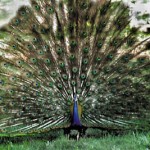 Also known as the Mahendra Chaudhary Zoological Park, Chhatbir zoo, the distinguished zoological garden is located at a distance of 17 km from Chandigarh and 55 km from Patiala. The zoo sprawls across an expanse of 202 acres against a stunning green backdrop.
Also known as the Mahendra Chaudhary Zoological Park, Chhatbir zoo, the distinguished zoological garden is located at a distance of 17 km from Chandigarh and 55 km from Patiala. The zoo sprawls across an expanse of 202 acres against a stunning green backdrop.
It is indeed a marvel to see how acres of raw scrubland have been transformed into a wonderful home for wild animals. The zoo paints a magnificent picture of the underlying ecological harmony that enhances the charm of the beautiful surroundings. The animals are kept in open enclosures so that their behavioral and physical needs can be met akin to their natural habitat.The main attraction of the Chhatbir zoo Chandigarh is the Royal Bengal Tiger, which has developed into the perfect point of interest for visiting the zoo. Visitors are taken in a caged motor vehicle to the tiger’s refuge to savor its attractions. While traveling inside the tiger’s refuge, the visitors can enjoy close ups of this magnificent animal.The Chandigarh zoo’s prized possessions are its eighty species of rare animals and variegated birds, dappled in a multitude of colors as well as fish and reptiles. The Chhatbir zoo Chandigarh officials go great lengths to keep the animals in an enclosure that closely resembles their natural habitat. The animals reside in large moats, surrounded by greenery and present an island like ambience.
 The Chhatbir Zoo is the perfect place for picnic as it also has a water body and large wooded parks and jungle area. Children come here for a fun-filled day and also learn a lot about the different animals by carrying out research on them. During the winters the rush increases due to pleasant climate during the daytime. Many zoologists also visit the Chandigarh zoo for carrying out research on various species of life.
The Chhatbir Zoo is the perfect place for picnic as it also has a water body and large wooded parks and jungle area. Children come here for a fun-filled day and also learn a lot about the different animals by carrying out research on them. During the winters the rush increases due to pleasant climate during the daytime. Many zoologists also visit the Chandigarh zoo for carrying out research on various species of life.
To Reach Chandigarh
By road:
There is an excellent road network in Chandigarh. There are two national highways, namely, No. 21 (Ambala-Kinnaur) and 22 (Chandigarh-Leh) that serve this union territory by connecting it with other parts of the country. Infact, there are many pilgrimage spots and famous towns that are located at a motorable distance. There are several buses that link Chandigarh with other neighboring cities. Buses are of different kinds: air-conditioned, deluxe, semi-deluxe or ordinary.
By Train
The city is well connected with major cities via train. There are two trains, namely, Shatabdi Express and Himalayan Queen that link Chandigarh with Delhi and the best part is that these trains run daily.
By Air
The city is well connected with Delhi, Leh and Amritsar via air. The airport is located at a distance of about 12 kms from the city center.
Fact File:
| Area | 114 sq kms |
| Longitude | 760 47′ 14E |
| Latitude | 300 44′ 14N |
| Monsoon | July-September |
| Temperature | Winter Min. (Nov.-Jan, 2006) 10 C-160 CSummer Max. (April-July, 2004) 270C-440C |
| Total Population (2001 census) | 9,00,635 |
Submit your review | |
